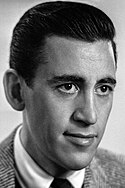J.D. Salinger Quote
One of the few things left in the world, aside from the world itself, that sadden me every day is an awareness that you get upset if Boo Boo or Walt tells you you're saying something that sounds like me. You sort of take it as an accusation of piracy, a little slam at your individuality. Is it so bad that we sometimes sound like each other? The membrane is so thin between us. Is it so important for us to keep in mind which is whose... For us, doesn't each of our individualities begin right at the point where we own up to our extremely close connections and accept the inevitability of borrowing one another's jokes, talents, idiocies?
J.D. Salinger
One of the few things left in the world, aside from the world itself, that sadden me every day is an awareness that you get upset if Boo Boo or Walt tells you you're saying something that sounds like me. You sort of take it as an accusation of piracy, a little slam at your individuality. Is it so bad that we sometimes sound like each other? The membrane is so thin between us. Is it so important for us to keep in mind which is whose... For us, doesn't each of our individualities begin right at the point where we own up to our extremely close connections and accept the inevitability of borrowing one another's jokes, talents, idiocies?
Related Quotes
About J.D. Salinger
Jerome David Salinger ( SAL-in-jər; January 1, 1919 – January 27, 2010) was an American author best known for his 1951 novel The Catcher in the Rye. Salinger published several short stories in Story magazine in 1940, before serving in World War II. In 1948, his critically acclaimed story "A Perfect Day for Bananafish" appeared in The New Yorker, which published much of his later work.
The Catcher in the Rye (1951) was an immediate popular success; Salinger's depiction of adolescent alienation and loss of innocence was influential, especially among adolescent readers. The novel was widely read and controversial, and its success led to public attention and scrutiny. Salinger became reclusive, publishing less frequently. He followed Catcher with a short story collection, Nine Stories (1953); Franny and Zooey (1961), a volume containing a novella and a short story; and a volume containing two novellas, Raise High the Roof Beam, Carpenters and Seymour: An Introduction (1963). Salinger's last published work, the novella Hapworth 16, 1924, appeared in The New Yorker on June 19, 1965.
Afterward, Salinger struggled with unwanted attention, including a legal battle in the 1980s with biographer Ian Hamilton and the release in the late 1990s of memoirs written by two people close to him: Joyce Maynard, an ex-lover; and his daughter, Margaret Salinger.
The Catcher in the Rye (1951) was an immediate popular success; Salinger's depiction of adolescent alienation and loss of innocence was influential, especially among adolescent readers. The novel was widely read and controversial, and its success led to public attention and scrutiny. Salinger became reclusive, publishing less frequently. He followed Catcher with a short story collection, Nine Stories (1953); Franny and Zooey (1961), a volume containing a novella and a short story; and a volume containing two novellas, Raise High the Roof Beam, Carpenters and Seymour: An Introduction (1963). Salinger's last published work, the novella Hapworth 16, 1924, appeared in The New Yorker on June 19, 1965.
Afterward, Salinger struggled with unwanted attention, including a legal battle in the 1980s with biographer Ian Hamilton and the release in the late 1990s of memoirs written by two people close to him: Joyce Maynard, an ex-lover; and his daughter, Margaret Salinger.
